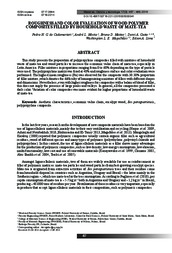Roughness and color evaluation of wood polymer composites filled by household waste of mate-tea.
Roughness and color evaluation of wood polymer composites filled by household waste of mate-tea.
Author(s): CADEMARTORI, P. H. G. de; MISSIO, A. L.; MATTOS, B. D.; GATTO, D. A.; MAGALHAES, W. L. E.; LIMA, E. A. de
Summary: This study presents the preparation of polypropylene composites filled with mixtures of household waste of mate-tea and wood particles to increase the economic value chain of mate-tea, especially in Latin America. Filler mixtures in proportions ranging from 0 to 60% depending on the type of particle were used. The polypropylene matrix was fixed at 40% and roughness surface and color evaluation were performed. The highest mean roughness (Ra) was observed for the composite with 30:30% proportion of filler mixture, which denotes the difficulty of homogenizing a mixture of fillers with different shapes and dimensions. Nevertheless, even with higher roughness for composites with a balanced blend of filler, this does not imply the presence of large peaks and valleys. In general, all the composites presented a dark color. Variation of color composites was more evident for higher proportions of household waste of mate-tea.
Publication year: 2015
Types of publication: Journal article
Unit: Embrapa Forestry
Observation
Some of Embrapa's publications are published as ePub files. To read them, use or download one of the following free software options to your computer or mobile device. Android: Google Play Books; IOS: iBooks; Windows and Linux: Calibre.
Access other publications
Access the Agricultural Research Database (BDPA) to consult Embrapa's full library collection and records.
Visit Embrapa Bookstore to purchase books and other publications sold by Embrapa.

